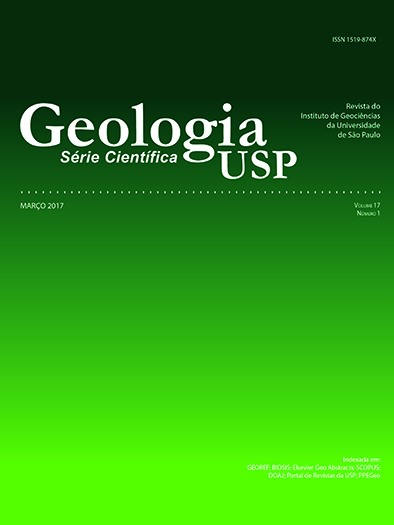Ortognaisse Morro do Resende: mineralogia, petrografia, geoquímica e geocronologia
DOI:
https://doi.org/10.11606/issn.2316-9095.v17-285Palavras-chave:
Ortognaisse, Mineralogia, Petrografia, Riaciano, Cinturão Mineiro.Resumo
O ortognaisse Morro do Resende aflora próximo à mina da Volta Grande, no município de Nazareno, estado de Minas Gerais, e corresponde a um corpo hololeucocrático a leucocrático, fino e de composição monzogranítica a granodiorítica. Apresenta xenólitos de rochas metamáficas da sequência metavulcano-sedimentar Rio das Mortes e possui idade de cristalização U-Pb SHRIMP de 2174 ± 4 Ma, possibilitando sua correlação a um dos pulsos magmáticos do cinturão Mineiro. Sua mineralogia primária é representada por quartzo, albita, microclínio, biotita, allanita, zircão, magnetita, titanita e apatita, enquanto os minerais metamórficos correspondem a sericita, epidoto, zoisita, clinozoisita, carbonato e clorita. Maghemita, barita, fluorita, monazita, xenotímio, granada e fluoretos de elementos de terras raras (ETR) (possivelmente gagarinita) são minerais de origem hidrotermal, pois ocorrem preenchendo fraturas, intercrescidos ou substituindo os minerais primários e metamórficos, sendo que a percolação desse fluido não ocorreu de forma homogênea ao longo de todo o corpo. A paragênese metamórfica indica condições de fácies xisto verde, que pode estar correlacionada ao evento paleproterozoico II do cinturão Mineiro, com idade entre 2131 e 2101 Ma. Esse corpo apresenta acentuado enriquecimento no conteúdo de ETR, anomalia negativa de Eu associada ao processo de cristalização magmática e anomalia negativa de Ce correlacionada à circulação de fluidos hidrotermais oxidantes.
Downloads
Publicado
Edição
Seção
Licença
Autores que publicam nesta revista concordam com os seguintes termos:
- Autores mantém os direitos autorais e concedem à revista Geologia USP. Série Científica, o direito de primeira publicação, com o trabalho sob a licença Creative Commons BY-NC-SA (resumo da Licença: https://creativecommons.org/licenses/by-nc-sa/4.0 | texto completo da licença: https://creativecommons.org/licenses/by-nc-sa/4.0/legalcode) que permite o compartilhamento do trabalho de forma não comercial e conferindo os devidos créditos autorais da primeira publicação nesta revista.
- Autores têm autorização para assumir contratos adicionais separadamente, para distribuição não-exclusiva da versão do trabalho publicada nesta revista (publicar em repositório institucional ou como capítulo de livro), conferindo os devidos créditos autorais da primeira publicação nesta revista.
- Autores têm permissão e são estimulados a publicar e distribuir seu trabalho online (em repositórios institucionais ou na sua página pessoal) a qualquer ponto antes ou durante o processo editorial, uma vez que isso pode gerar alterações produtivas, bem como aumentar o impacto e a citação do trabalho publicado (Veja O efeito do Acesso Aberto e downloads no impacto das citações).















